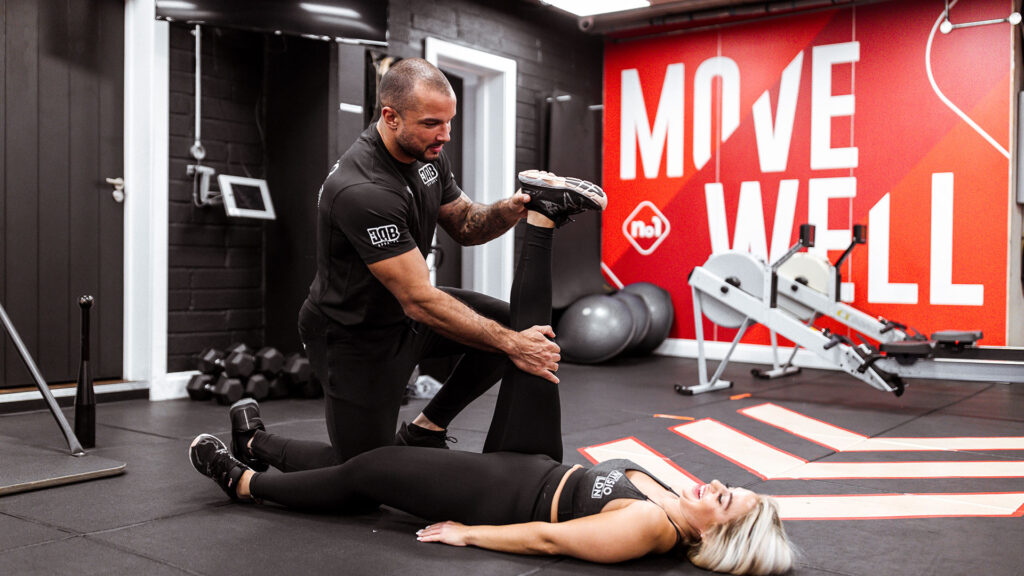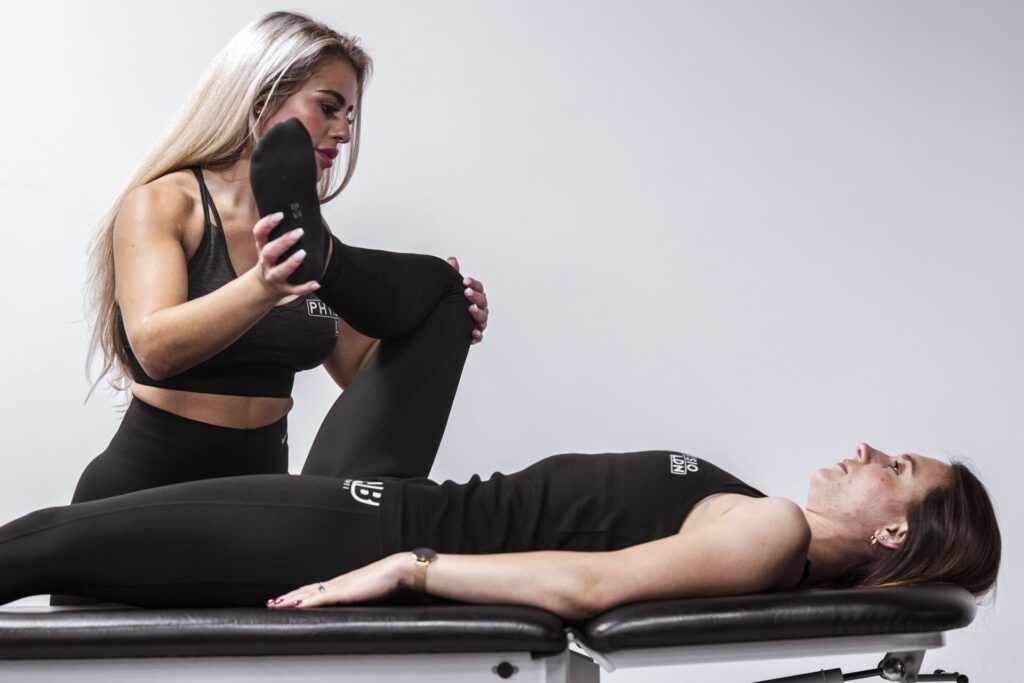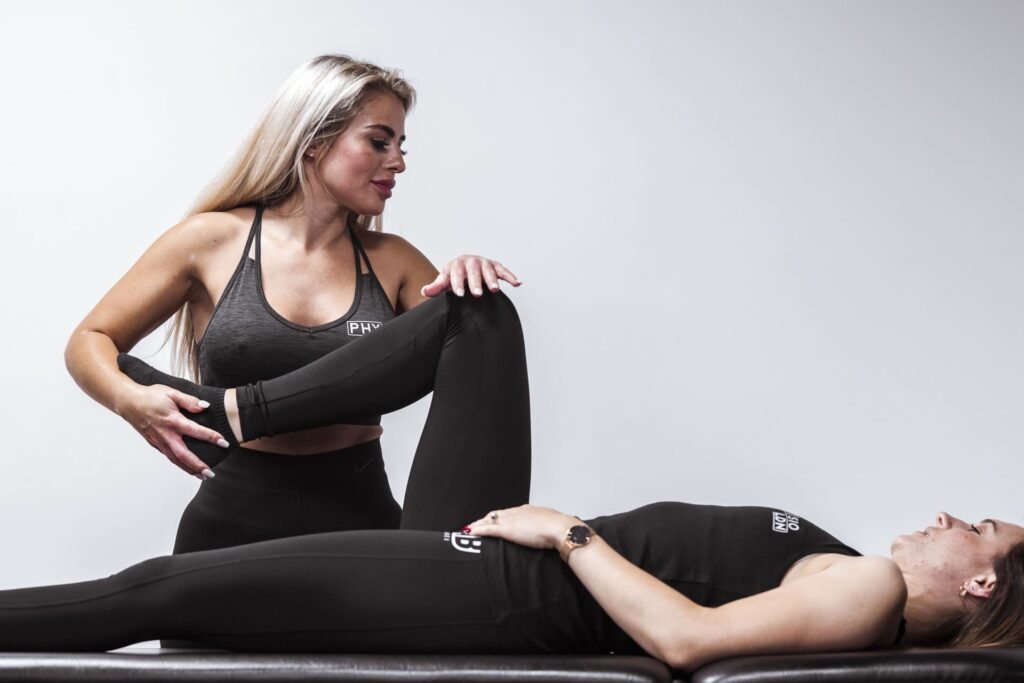Table of Contents
Main Takeaways
- Prevalence: Knee pain affects 10.9% of young athletes, showing early onset in active youth.
- Injuries: Common issues include ACL sprains, meniscal tears, patellar tendonitis, and early osteoarthritis.
- Prevention: Strength training, proper technique, balance, footwear, and rest are crucial.
- Rehab: Physiotherapy with manual therapy, tailored exercises, and education accelerates recovery.
- Technology: Wearables and deep learning tools now track and reduce knee injury risks in real time.
- Clinic Highlight: One Body LDN offers evidence-based rehab, deep tissue therapy, and advanced modalities for long-term recovery.
Knee pain is a common complaint among athletes of all ages and skill levels, often resulting from the high demands and repetitive stress placed on this vital joint. Studies show that approximately 10.9% of young athletes aged 6–15 experience knee pain, with 13-year-olds being particularly affected, highlighting the early onset of knee issues in active youth.
Understanding the causes, prevention, and rehabilitation of knee pain is essential for athletes to maintain peak performance and long-term joint health. For local readers, exploring knee pain treatment in London can provide quick access to targeted assessment and sport-specific care.
Whether you are a weekend warrior, a competitive athlete, or a coach, knowing how to manage knee pain can help you avoid chronic problems and enjoy a more active lifestyle. This article explores the most common knee injuries in sports, effective prevention strategies, and the latest approaches to rehabilitation and recovery.
Common Injuries in Sports
Knee injuries in athletes often result from trauma, overuse, or biomechanical imbalances. Some of the most frequent conditions include meniscal tears, ligament sprains (especially the anterior cruciate ligament or ACL), patellar tendonitis, and early osteoarthritis. Notably, a prospective study involving 129 patients revealed that classical symptoms of meniscal and cruciate tears are often absent, making diagnosis challenging and underscoring the importance of thorough clinical and sometimes arthroscopic examinations .

Dr. John Smith, an orthopedic surgeon, explains that “the repetitive and high-impact nature of many sports places excessive strain on the joints, making athletes more susceptible to early osteoarthritis” . This highlights the need for early intervention and proper management to prevent long-term joint damage. Additionally, the psychological impact of knee injuries cannot be overlooked; athletes often face anxiety about re-injury and may struggle with the mental aspect of returning to their sport after a significant injury.
Patellar tendon injuries are another common concern, particularly in sports involving jumping and rapid direction changes. Recent analyses of the top 50 influential studies on patellar tendon injuries have advanced understanding and treatment options, improving outcomes for athletes suffering from this condition .
These injuries can cause significant pain and limit athletic performance if not addressed promptly. Rehabilitation programs focusing on eccentric strengthening exercises have shown promising results in reducing pain and enhancing recovery times, allowing athletes to return to their sport more quickly and safely.
Moreover, the role of proper footwear and surface conditions in preventing knee injuries is gaining attention. Studies indicate that wearing sport-specific shoes designed to provide adequate support and cushioning can significantly reduce the risk of injury. Additionally, training on surfaces that minimize impact, such as synthetic tracks or grass fields, can further protect athletes’ knees.
As awareness grows, coaches and trainers are increasingly incorporating these elements into their training regimens to promote safer athletic practices. For detail information see the blog knee pain diagnosis: tests, imaging & when to seek help.
Prevention Tips
Preventing knee pain and injury in athletes requires a multifaceted approach that includes strength training, proper technique, and adequate recovery. Strengthening the muscles around the knee, such as the quadriceps, hamstrings, and calves, helps stabilize the joint and absorb impact forces. Incorporating balance and proprioception exercises can also reduce the risk of injury by improving joint awareness and control. For instance, exercises like single-leg stands or stability ball workouts can enhance coordination and muscle engagement, which are vital for maintaining knee integrity during dynamic sports activities.
Biomechanical assessments and movement pattern corrections are crucial, as improper form during sports activities can increase joint stress. For example, deep learning technologies have recently shown promise in monitoring on-field knee injury risk by accurately predicting knee joint moments during complex movements like sidestepping, enabling targeted interventions . Furthermore, wearable technology is becoming increasingly popular among athletes, providing real-time feedback on movement mechanics and allowing for immediate adjustments to technique, which can significantly mitigate the risk of injury.
If pain persists despite preventive strategies, consulting a professional knee pain physiotherapist can help identify underlying biomechanical issues and tailor a sport-specific rehab plan.
Additionally, educating young athletes about the importance of rest and gradual progression in training intensity can prevent overuse injuries. Cross-training and avoiding repetitive strain on the same joint are also beneficial strategies. Given that knee symptoms can increase the risk of pain in other body regions, a holistic approach to athlete health is essential .
Moreover, incorporating flexibility training, such as yoga or dynamic stretching routines, can enhance overall muscle elasticity and joint range of motion, further protecting the knee from injury. Nutrition also plays a pivotal role; a diet rich in anti-inflammatory foods can support recovery and joint health, ensuring that athletes remain in peak condition throughout their training and competition seasons.
Rehabilitation and Recovery
Effective rehabilitation is key to restoring knee function and preventing re-injury. Physiotherapy plays a central role, combining manual therapy, exercise prescription, and patient education. Clinics such as One Body LDN in London provide expert musculoskeletal physiotherapy, blending deep tissue massage with tailored rehab exercises to address the root causes of knee pain and promote long-term recovery.

Rehabilitation programs typically begin with pain and inflammation control, followed by gradual strengthening and mobility work. Post-operative rehab, especially after ACL reconstruction or meniscal surgery, requires careful progression aligned with surgical protocols to rebuild strength and confidence safely. Evidence-based physiotherapy techniques, including joint mobilizations and neuromuscular training, help athletes return to their sport at full capacity.
One Body LDN’s award-winning physiotherapists, who receive over five times the required regulatory training, emphasize a hands-on approach and bespoke exercise plans, ensuring patients achieve rapid and sustained improvements . Their clinics across London offer convenient access to expert care, supporting athletes from initial assessment through to full recovery.
In addition to traditional physiotherapy techniques, One Body LDN incorporates innovative modalities such as dry needling and ultrasound therapy, which can significantly enhance the healing process. Dry needling targets trigger points in the muscles, helping to alleviate pain and improve mobility, while ultrasound therapy promotes tissue repair at a cellular level. These advanced treatments are particularly beneficial for athletes looking to expedite their recovery and return to peak performance.
Furthermore, the clinic emphasizes the importance of education in the rehabilitation process. Patients are encouraged to understand their injuries and the mechanics of their movements, which fosters a proactive approach to their recovery. Workshops and one-on-one sessions equip individuals with the knowledge to prevent future injuries, making them active participants in their rehabilitation journey.
This holistic approach not only aids physical recovery but also empowers patients mentally, instilling confidence as they progress through their rehabilitation. For sustained performance and joint health, pairing sport-specific rehab with effective knee pain treatments can help athletes return stronger and stay injury-resilient.
FAQ
What are the most common causes of knee pain in athletes?
Knee pain in athletes is often caused by injuries such as meniscal tears, ligament sprains (especially ACL), patellar tendonitis, and overuse conditions leading to early osteoarthritis. Repetitive high-impact activities and improper movement patterns increase the risk. Additionally, factors such as inadequate warm-up routines, insufficient flexibility, and muscle imbalances can exacerbate the likelihood of knee injuries. Athletes participating in sports that involve sudden stops, jumps, or changes in direction, such as soccer, basketball, and football, are particularly vulnerable to these types of injuries. Understanding these causes can help athletes and coaches implement better training regimens to minimize risks.
How can young athletes prevent knee injuries?
Prevention strategies include strengthening the muscles around the knee, improving balance and proprioception, using proper technique, avoiding overtraining, and incorporating rest days. Early education on safe training practices is vital. Furthermore, engaging in cross-training activities can enhance overall fitness and reduce the repetitive strain on the knee joint. Young athletes should also be encouraged to listen to their bodies and recognize the signs of fatigue or discomfort, which may indicate the need for a break or modification of their training routine. By fostering a culture of injury prevention and awareness, coaches and parents can play a crucial role in safeguarding young athletes’ long-term health.
Is physiotherapy effective for knee pain recovery?
Yes, physiotherapy is highly effective in managing and rehabilitating knee pain. It combines manual therapy, exercise rehabilitation, and education to reduce pain, restore function, and prevent future injuries. Physiotherapists also utilize modalities such as ultrasound, electrical stimulation, and ice or heat therapy to enhance recovery. A tailored rehabilitation program not only addresses the immediate pain but also focuses on correcting biomechanical issues and strengthening surrounding muscles to support the knee. This comprehensive approach ensures that athletes can return to their sport safely and with a lower risk of re-injury.
When should an athlete seek medical advice for knee pain?
If knee pain persists beyond a few days, worsens, or is accompanied by swelling, instability, or difficulty bearing weight, it is important to seek professional assessment to rule out serious injuries. Additionally, athletes should be vigilant for signs such as a popping sound during injury, significant bruising, or a feeling of the knee giving way. Prompt medical evaluation can lead to early diagnosis and treatment, which is crucial for a successful recovery. Athletes should not hesitate to consult a healthcare professional if they have any concerns, as early intervention can significantly improve outcomes.
Can knee pain in athletes lead to other body pains?
Yes, studies show that athletes with knee symptoms have an increased risk of experiencing pain in other body regions, indicating the interconnected nature of musculoskeletal health. For instance, compensatory movements due to knee pain can lead to strain in the hips, lower back, and even the ankles. This phenomenon highlights the importance of a holistic approach to injury management, where addressing knee pain may also alleviate discomfort in other areas. Furthermore, chronic knee pain can alter an athlete’s biomechanics, potentially leading to long-term issues if not properly addressed.
Are there new technologies to help monitor knee injury risk?
Recent developments in deep learning and biomechanical monitoring allow for real-time assessment of knee joint stress during athletic movements, helping to identify and mitigate injury risks. Wearable technologies, such as smart insoles and motion sensors, can track an athlete’s gait and movement patterns, providing valuable data to coaches and trainers. This information can be used to adjust training loads and techniques proactively, reducing the likelihood of injuries. As these technologies continue to evolve, they hold the promise of enhancing athlete performance while ensuring safety, making them an essential tool in modern sports training and injury prevention strategies.
Start Your Road to Recovery with One Body LDN
Don’t let knee pain hold you back from your athletic pursuits or daily activities. At One Body LDN, voted as the best London physio clinic by thousands, we understand the intricacies of sports-related injuries and the importance of addressing the root cause. Our award-winning team of physiotherapists, including former athletes and NHS specialists, is dedicated to providing you with expert assessments and personalized rehab plans. Whether you’re dealing with a gym injury, muscle tear, or post-operative recovery, we’re here to offer immediate pain relief and long-term solutions. Take the first step towards feeling amazing and book your free initial assessment at our clinic today. With One Body LDN, you’re in great hands, and we’re committed to getting you back in action without overselling treatments. Experience the difference with our results-based approach.
References
- BMC Sports Science – Prevalence of knee pain in young athletes
- PubMed – Meniscal and cruciate tears symptom variability
- Athletic Store – Early osteoarthritis in athletes
- SAGE Journals – Patellar tendon injury research
- arXiv – Deep learning for knee injury risk prediction
- BMC Sports Science – Musculoskeletal pain risk association


